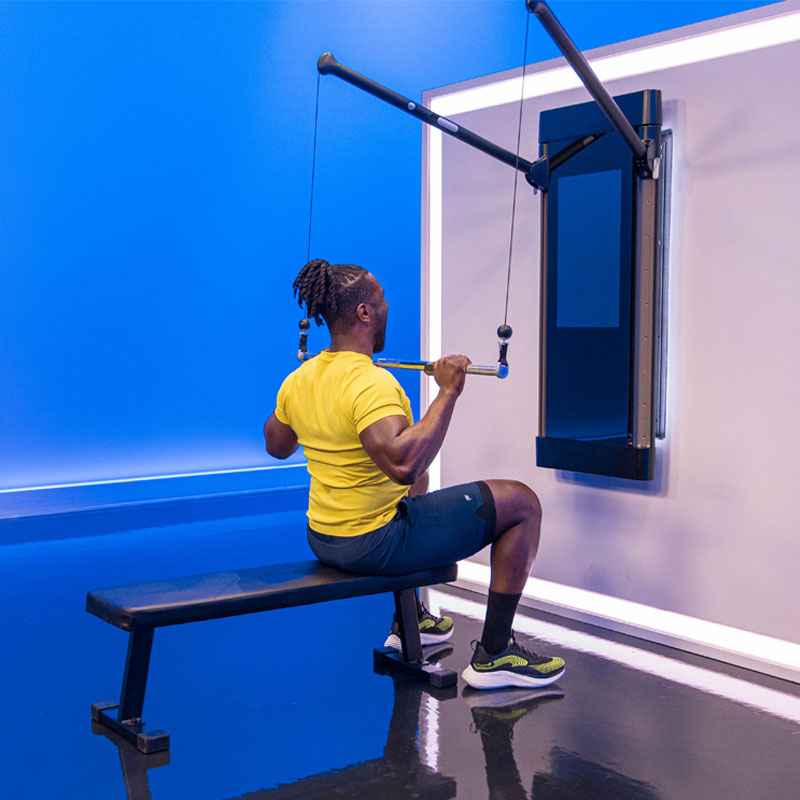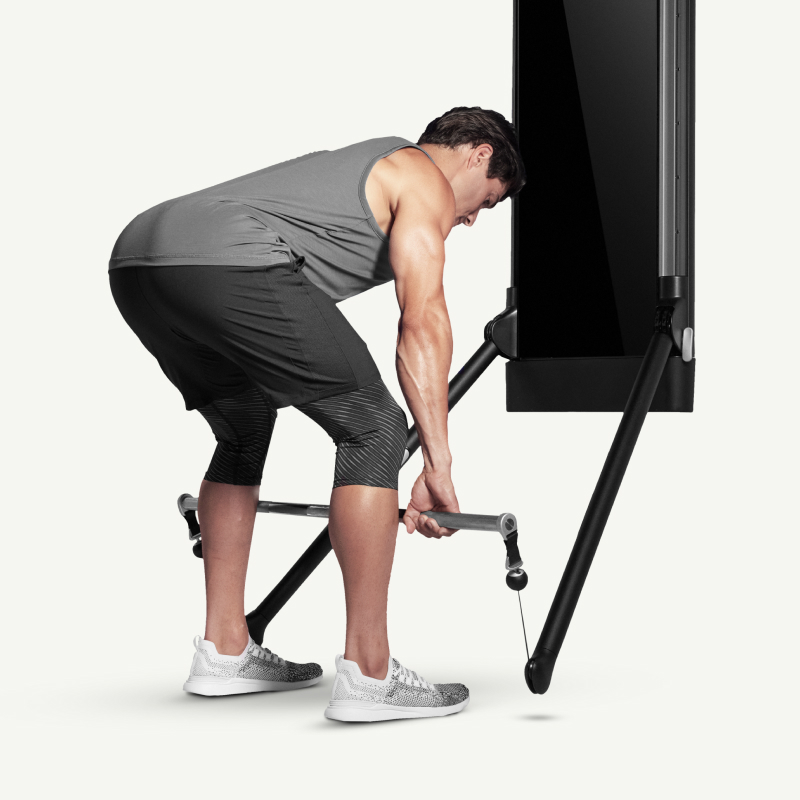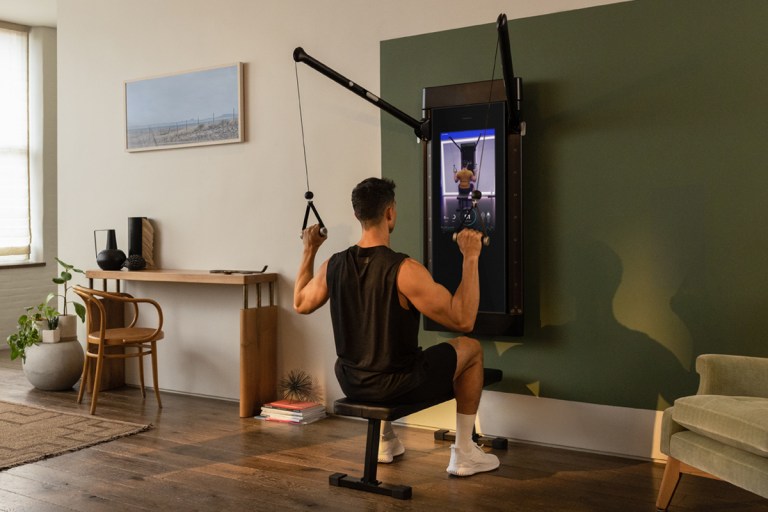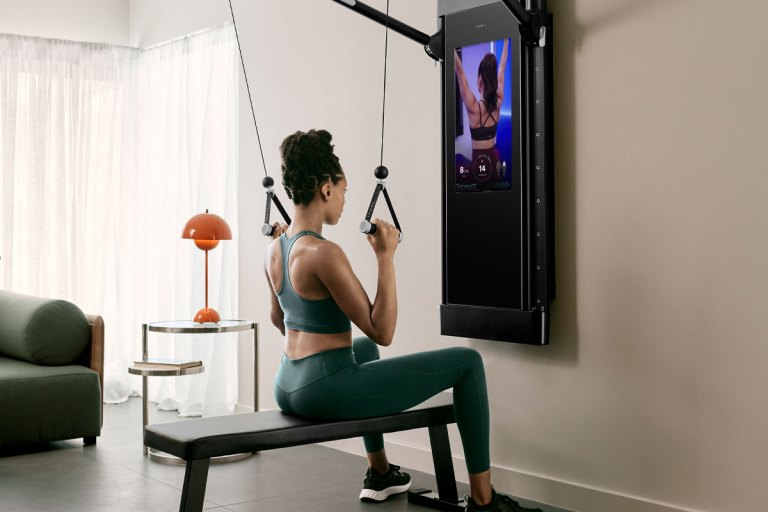Build Back Strength and Better Posture With This At-Home Lats Workout
These exercises will target the largest muscles of your back so you can look strong and move powerfully.

Your latissimus dorsi (or lats) are a lot like the foundation of a building: You can’t see them, but they’re essential for stability and strength. These broad, triangle-shaped muscles are the largest of your back, spanning from each side behind your arms to your spine, and are essential for maintaining an upright posture and achieving everyday tasks without pain.
Beyond their functional benefits, your lats are also responsible for movements including raising, lowering, and rotating the upper arms. Plus, muscular lats can help you achieve specific aesthetic goals. “The ‘V-taper’ which is common amongst bodybuilders gives the illusion of a broad frame and small waist,” says Tonal coach and personal trainer Ackeem Emmons.
Plus, with the right equipment, you can complete a lats workout at home to give these muscles the attention they need and achieve the results you desire. Here are Emmons’ tips for creating a lats workout at home that’ll get your back burning as you develop serious strength.
How Often Should You Train Your Lats?
Even if building bigger lats is your main priority, there’s no need to work your lats every day. Emmons suggests including lats exercises in two workouts per week. “One day should be dedicated to mobility and form and the other to isolation strength work,” he says. Research suggests that performing 10 sets per muscle group per week is ideal for hypertrophy, and you can easily divide your sets of lats work over two days with a mix of different exercises. Splitting up your lats workouts also gives the muscles time to rest and recover in-between sessions.
How Long Does it Take to Build Lats?
With two weekly workouts that include lats exercises, Emmons says you can expect to see muscular size and strength gains within four to six weeks. However, he adds, you’ll likely notice mobility gains much sooner, and these mobility improvements will benefit your big lifts. If you’re hitting a plateau, he suggests dropping the weight and concentrating on your range of motion. As a 2020 review of studies shows, lifting with full range of motion may lead to greater gains in hypertrophy.
Do Squats Build Lats?
Along with isolation exercises that target your lats, you can also work these muscles with compound exercises. Front and back squats strengthen your lats as you need to use your back muscles to keep your torso upright while under resistance. You’ll also work your lats during deadlifts as you hold the barbell and keep it close to your body. These exercises have the added benefit of getting your lower body involved as well, for more muscle-building in less time, as well as an additional metabolic boost.
Best Exercises for a Lats Workout at Home
Below are Emmons’s recommended exercises for an at-home lats workout. The warmup moves can be done without any equipment, so if you’re working with just your body weight, consider doing additional sets of these moves or adding them to a longer bodyweight workout.
Warmup: 1 Set
Superhero Iso Hold: 30 seconds

Why it Works: This bodyweight move is a solid addition to any lats workout at home because it engages your lats without equipment. Learning to engage your lats without resistance will help when it comes time to pack on the weight.
How to Do it: Lie face down on your mat. Extend your arms upward and out about 45 degrees from your head. Extend your legs about hip distance apart. Imagine strings from the ceiling lifting all 4 limbs off the floor while you balance on your pelvis and low belly. With your back and glutes engaged, hold this position.
Reach and Rotate Opener: 30 seconds each side

Why it Works: Another bodyweight mobility exercise, this move opens up your shoulders and thoracic spine, developing range of motion for your lifts. “It builds a stronger posture and provides a lower-back stretch,” says Emmons.
How to Do it: Get into a tall kneeling position on your mat and then sit back on your heels. Bring one hand out in front of you on the floor and the other just behind your ear, bending at the elbow. Rotate at the torso like you’re wringing out a towel, opening your body to the same side as your raised arm. Come back to face the floor and repeat on the same side.
Block 1: 1 Set
Pillar Bridge With Row: 20 seconds each side

Why it Works: Consider this move an extended warmup as it continues the focus on mobility by challenging your core while adding in a row to strengthen the lats.
How to Do it: Get into a pillar bridge a few feet away from Tonal’s arm with both elbows on the mat under the shoulders and feet hip distance apart, toes tucked. Grab the handle with one hand and pull toward your shoulder aiming the elbow toward the ceiling, rotating your palm to face your body. Slowly control the weight back to the starting position and repeat on the same side.
Barbell Seated Lat Pulldown: 12 reps

Why it Works: A traditional vertical pull exercise, the lat pulldown is a foundational move for isolating the lats. With both sides of your back working to pull the bar, you can load up the weight to push those lats gains.
How to Do it: Facing Tonal, sit straddling the bench slightly behind the end of the arms and grip the bar slightly wider than shoulder width. Using your back, pull the bar toward your collar bones by bending your elbows and drawing them down like there are magnets on your elbow and rib cage. Let the weight back up with control, straightening at the elbows, and repeat.
Alternating Neutral Lat Pulldown: 10 reps

Why it Works: This single-sided lat pulldown variation challenges you to work each side of the back individually to balance out any asymmetries. “The unilateral pattern engages the core and lats,” says Emmons.
How to Do it: Start with arms extended overhead, palms facing Tonal. Using your back, pull one handle to the outside of your shoulder, rotating it to face inward, and bend your elbow like there are magnets on your elbow and rib cage. Slowly control the weight back up and alternate sides.
Block 2: 3 Sets
Barbell Chinup: As many reps as possible

Why it Works: Chinups are one of Emmons’s top picks for isolating the lats muscles. Compared to the lat pulldown, this exercise requires more involvement from the lower lats so it’s great for working the entire muscle group.
How to Do it: Grip the bar shoulder width apart with palms facing your body. Get into a tall kneeling position with your toes tucked on the floor. Using your back, pull the bar toward your collar bones by bending your elbows and drawing them down and back away from Tonal. Control the weight back up, straightening at the elbows, and repeat.
Bent Over Row: 12 reps

Why it Works: This lift doesn’t just engage your lats, it also gets your other back muscles, including the traps and rhomboids, involved for well-balanced strength. Because your muscles are under tension through the entire movement, Emmons says this exercise is much more effective on Tonal than it would be with dumbbells.
How to Do it: Grab the handles and take a small step back. Position yourself in an athletic stance facing Tonal with feet hip-width apart. Hinge at the hips into a bent-over position. Start with your palms facing the floor and pull the handles toward your ribcage using your back, rotating the palms to face each other. Aim your elbows to where the ceiling meets the wall as you pull. Keep control of the weight using your back as you lower the handles and repeat.
Barbell Straight Arm Pulldown: 15 reps

Why it Works: If you’re struggling to feel your lats in other exercises, Emmons recommends this move for isolating the muscle group while working on your hinge pattern. Since we can’t see our lats in the mirror, Emmons explains that the mind-muscle connection in this area may not be as strong as it is compared to the muscles we can see, such as our biceps or quads. Take your time in this movement and you’ll definitely feel your lats light up.
How to Do it: Stand facing Tonal with feet hip-distance apart, knees soft. Grab the bar and take a step back. Start with the bar out in front of you, positioned slightly higher than your shoulders, elbows softly bent. Pull the bar down toward your hips, moving from the shoulders and back, squeezing your lats at the bottom. Then let the bar up with control until your hands are just above your shoulders and repeat.
Block 3: 3 Sets
Barbell Deadlift: 10 reps, 8 reps, 5 reps

Why it Works: While it’s primarily a lower-body exercise that strengthens your glutes and hamstrings, Emmons says there are also some lats benefits to be gained from the classic deadlift. As you work to maintain a neutral spine while lifting heavy, you’re forced to engage your entire posterior chain, including your lats. This compound exercise lets you sneak in extra back work without adding more isolation lifts to your lats workout at home.
How to Do it: Stand with feet hip-width apart, shoe laces lined up with the end of Tonal’s arms. Bend your knees and reach your hips back into a hinge position. Grab the bar with your hands outside your knees. Stand by pressing the floor away from you, pulling the bar up your thighs, and keeping your back as straight as a wall. Once at the top, keep your chest proud as you reach the hips back and return to the bottom position, then repeat.


